Miart 2024, the 10 best booths at Milan's contemporary art fair
Miart, Milan ’s international modern and contemporary art fair organized by Fiera Milano, which is now in its 28th edition this year, the fourth directed by Nicola Ricciardi, is kicking off. In fact, from April 12 to 14, 181 galleries from 28 countries are on display in Hall 3 of the Allianz MiCo Convention Center, bringing works of modern art and by established and emerging contemporary artists. The theme of the 2024 edition of Miart is no time no space, which aims to increasingly expand its boundaries both geographically and temporally. In addition to the main section (Established) and the Emerging section, new this year is the Portal section, deliberately anachronistic, which aims to blur the times to speak of our time, capturing in the ever-changing flux of immediate actuality what in art is stable and enduring. What are the ten best stands at Miart 2024 according to our editorial staff? As always, we visited the fair in preview and selected those that in our opinion stood out for originality of the proposal, novelty, care of the layout, scenographic impact, and clarity of display. Here they are below, in strict alphabetical order.
1. 193 Gallery
A booth... divided into three, that of Parisian gallery 193 Gallery. It starts with Thandiwe Muriu, a Kenyan artist born in 1990, who brings a gust of Africa to miart who, with her photographs that look like digital works, tackles the theme of self-perception while trying to redefine female identity through the choice of materials, and in particular of fabrics and styles that speak of Africa. Opposite is 37-year-old New Zealander Rob Tucker, a painter of landscapes and still lifes that are distinguished by their almost geometric shapes, playful palette, references to the world of design, and a gaze that turns, for example, to the painting of David Hockney. In between, it’s Africa again with Sesse Elangwe, a 1994 Cameroonian (though he lives in San Antonio, Texas), with his paintings that take cues from realism, Pop Art, and surrealism to chronicle the plight of black people around the world.
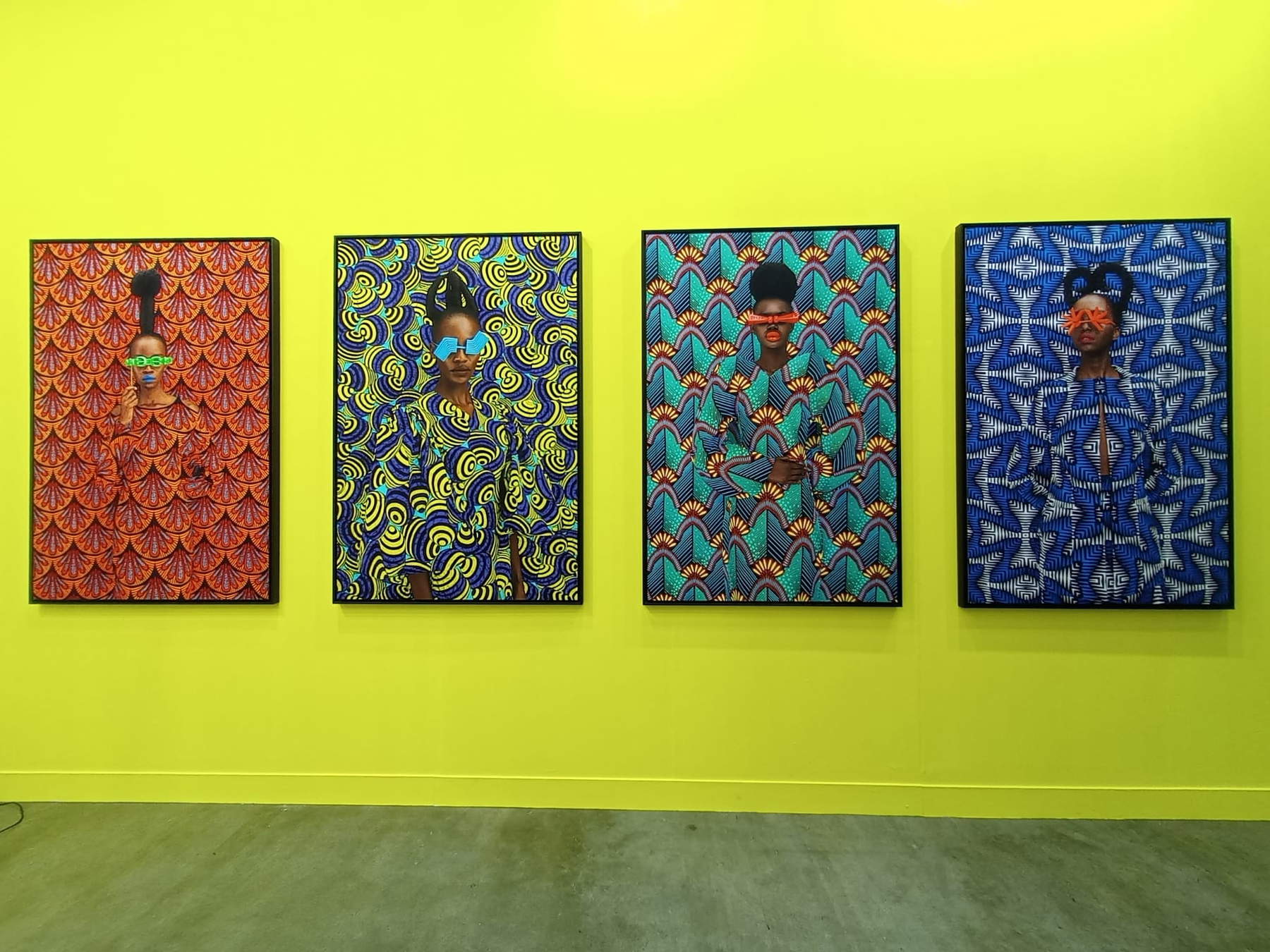
2. Andrew Kreps
American Andrew Kreps presents a dialogue, successful in our opinion, between the works of two very young artists-Henry Shum, born in Hong Kong in 1998, and Isabella Costabile, a Maremma-born artist born in New York in 1991. Shum paints by collecting images he encounters in both physical and digital spaces, and developing thematic connections through disparate materials. Two-dimensional and three-dimensional space often seem to fold into one another, suggesting the existence of multiple planes or virtualities within a single work. This suggestion does not reflect Shum’s desires, but instead reflects a specific reality of our times: the incessant maneuvering between the collective and the individual, the historical and the ahistorical. Isabella Costabile’s research starts from discarded objects and materials that give life to new and singular objects that are mindful of childhood and its games, but are also able to reflect on the possibilities of everyday language and the ambiguity of forms.
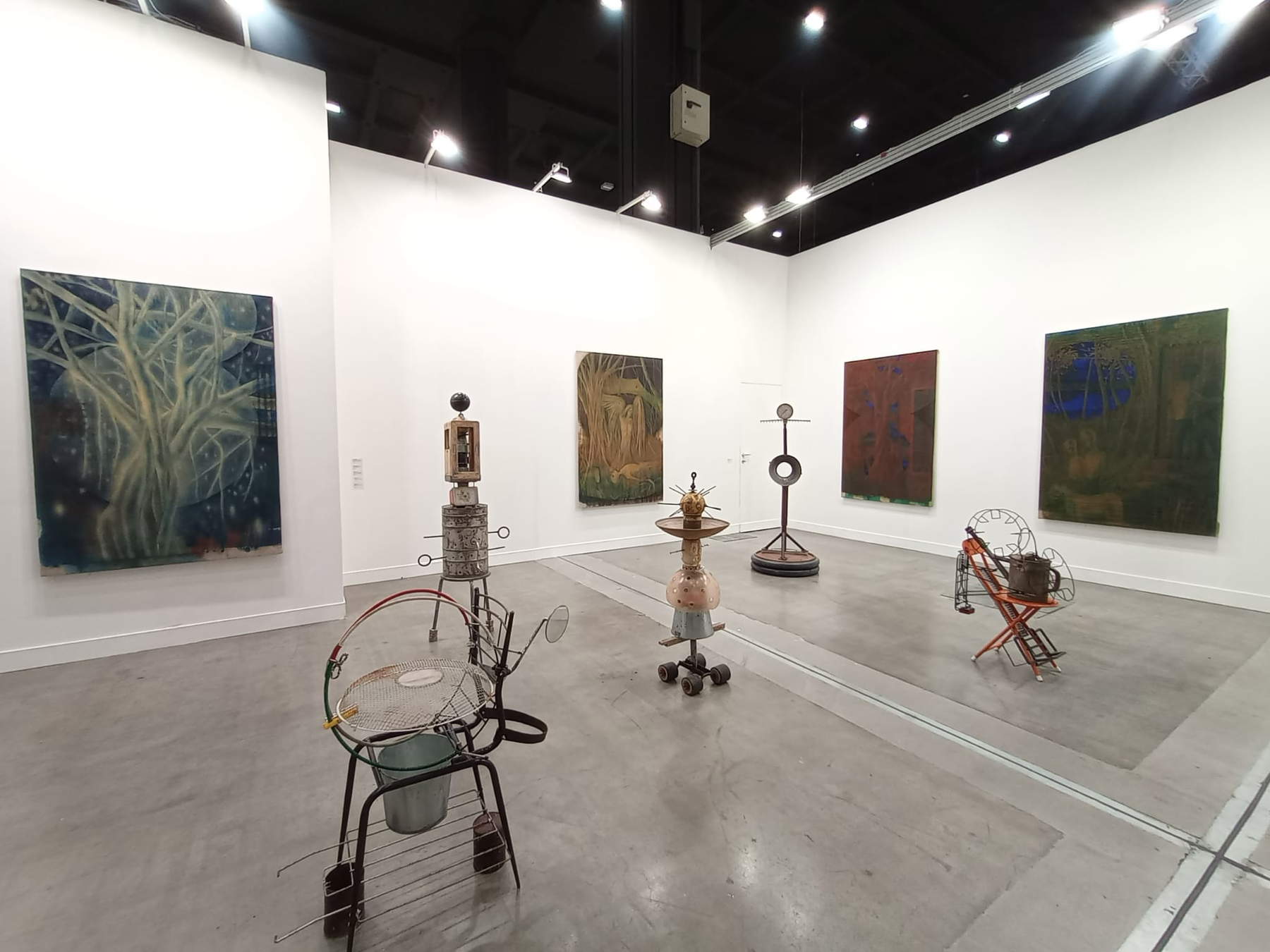
3. Bel Ami
British artist Alexis Soul-Gray, class of 1980, is the star of the solo show at the Bel Ami gallery in Los Angeles. Alexis Soul-Gray’s research combines painting, drawing and collage to investigate how imagination can illuminate a path through sadness and loss and how curiosity and experimentation bring out hidden layers, revealing the emotional life of childhood and how it conditions our perceptions and responses in adulthood. Appropriating images from Italian Renaissance painting and advertisements idealizing family life from popular British magazines, Soul-Gray finds scenes of women and children, choosing them for their artificial quality, “where family is often faked but also, somehow, felt.” He then delicately draws disturbing moments that seem unexpectedly real, such as a backward glance or a playful gesture. To break through the surface of these scenic, stylized compositions, Soul-Gray erases the facade by rubbing, scraping or even using caustic chemicals such as bleach. He paints or collages over the figures in an attempt to reconstitute their unstudied, piercing humanity. As the faded images become more transparent, the reassuring texture of canvas, linen or paper shines through. Through luminescent veils of blue and gold, Soul-Gray’s children, trapped in a vision of the past, suddenly emerge to the surface with a burst of realistic realism. For miart, Soul-Gray has painted, and is exhibiting in Bel Ami’s booth, a new series of seven small portraits of women and children, referencing the delicate bond between the Madonna and the child. The paintings are moreover hung on walls painted cobalt blue, symbolizing the purity of Renaissance painting. In Alexis Soul-Gray’s work, the same blue becomes the color of processing grief and arriving in a new place.
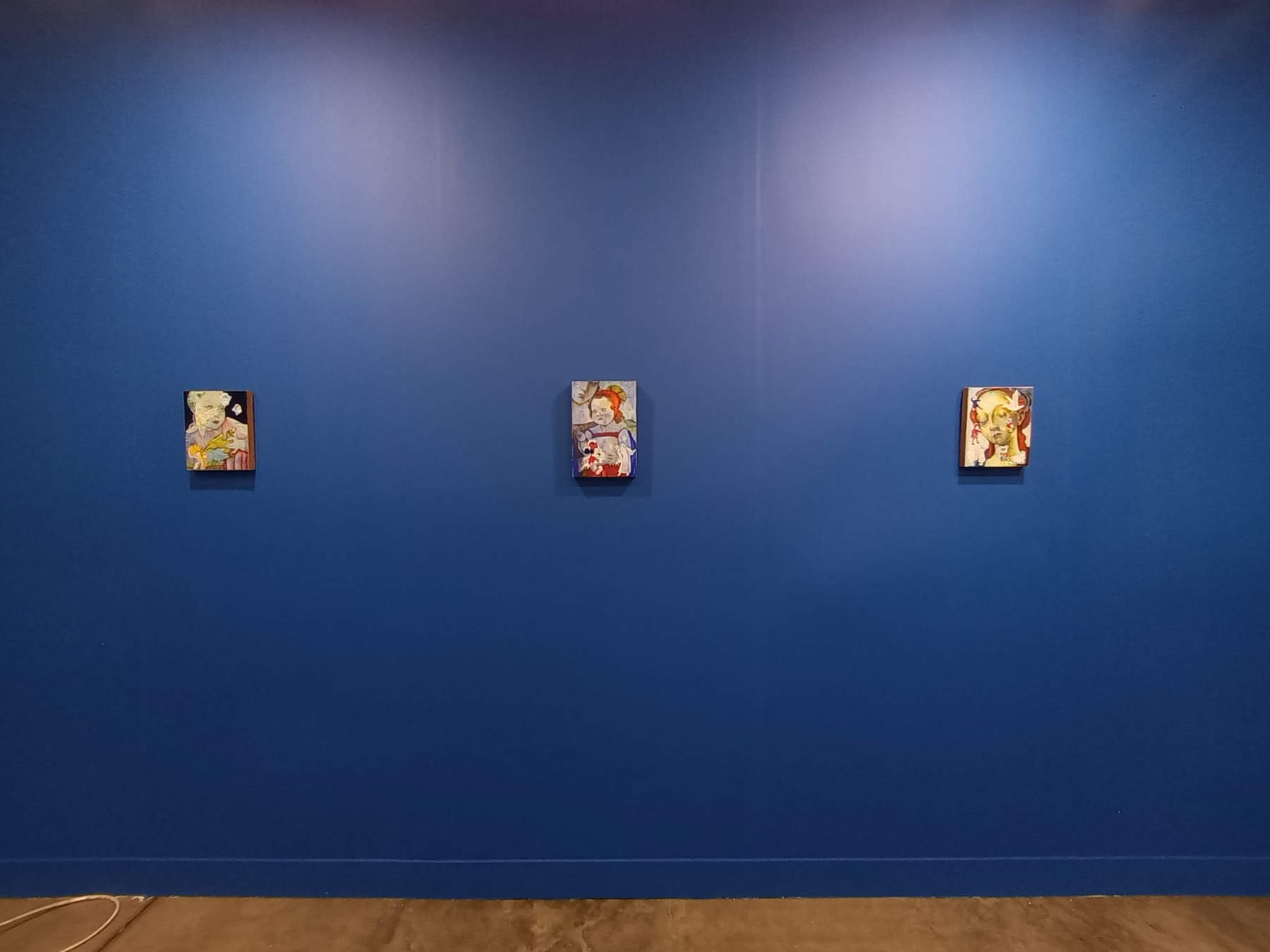
4. Eidos
That of Eidos is one of the most peculiar stands: the gallery has in fact developed a dialogue between two artists, Mario Schifano and Nam June Paik, both active in the 1970s and both able to explore the medium of television and the incessant flow of information and images that has brought us into the Internet age. Their visionariness allowed them to anticipate the era in which we find ourselves immersed. Schifano during the 1960s and 1970s lived in a studio dominated by dozens of televisions that were always on, constantly pouring a stream of images into his visual space. With the “Televisors” series, Schifano was one of the first artists to experiment with media to create a new artistic language, focusing on the speed of images and the ability to capture fragments to construct new narratives. Nam June Paik, also active during the same period, devoted his artistic research primarily to television and the concept of information flow. He conceptualized art as global communication, seeking to propose new artistic models outside traditional canons. In his performances, television became a metaphysical object, both container and content, turning into a kind of robotic sculpture that immediately interacted with viewers.
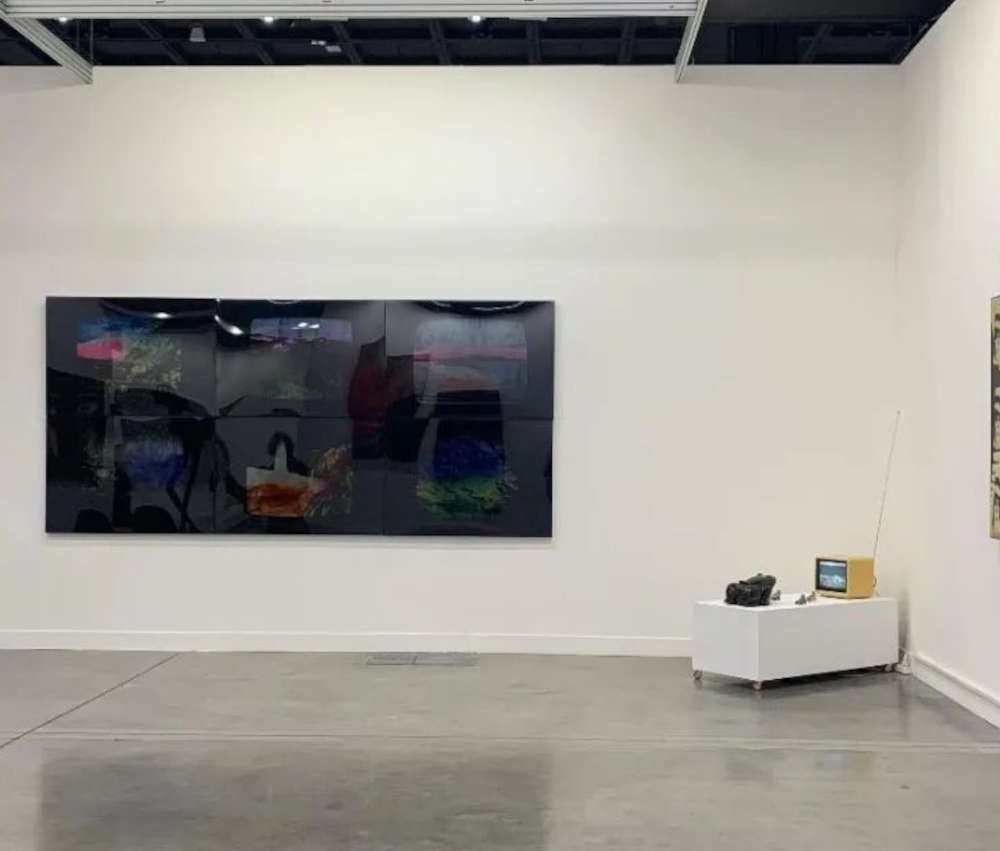
5. Carlo Virgilio & C. Gallery.
Definitely curious is the proposal of Carlo Virgilio, who sets the whole booth on the theme “kinship,” through an exhibition entitled. “Kinship. Six family stories.” Families of artists: the idea is to tell the feelings, affections, contrasts, joys and wearinesses. Here are the pairs of artists: Adolfo Wildt and Francesco Wildt (father and son), Giorgio De Chirico and Alberto Savinio (brothers), Nino Bertoletti and Pasquarosa (husband and wife), Paola Consolo and Gigiotti Zanoni (wife and husband), Pasquale Di Fabio and Alberto Di Fabio (father and son), Isabella Ducrot and Giuseppe Ducrot (mother and son). Works by artists spanning the ages, from the early twentieth century to the contemporary, with artists often to be rediscovered and still to be studied (starting with Francesco Wildt), and included among the most interesting proposals of this edition of Miart.
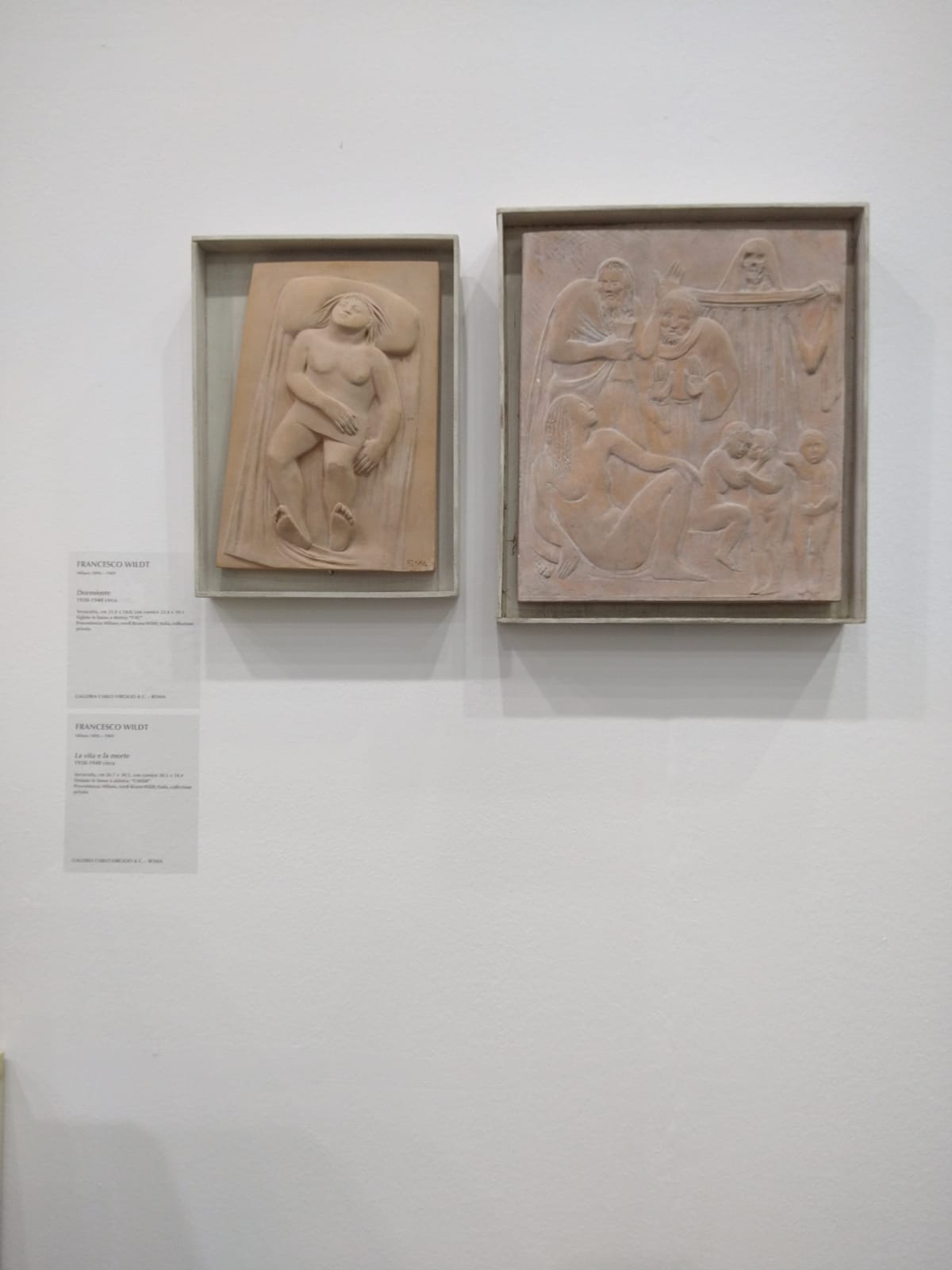
6. Franco Noero Gallery
A monographic exhibition of Anna Boghiguian is the proposal of Franco Noero Gallery, which explores the Cairo-born artist’s multifaceted artistic universe through vibrant paintings and... sculptures of birds hanging from the ceiling. The Turin gallery fits into the Portal section with an interesting and collected booth that offers an in-depth look into the recent production of the Armenian-born artist. Anna Boghiguian creates a universal dialogue, addressing themes such as migration, identity and memory, reflections of a wandering life, with effective immediacy.
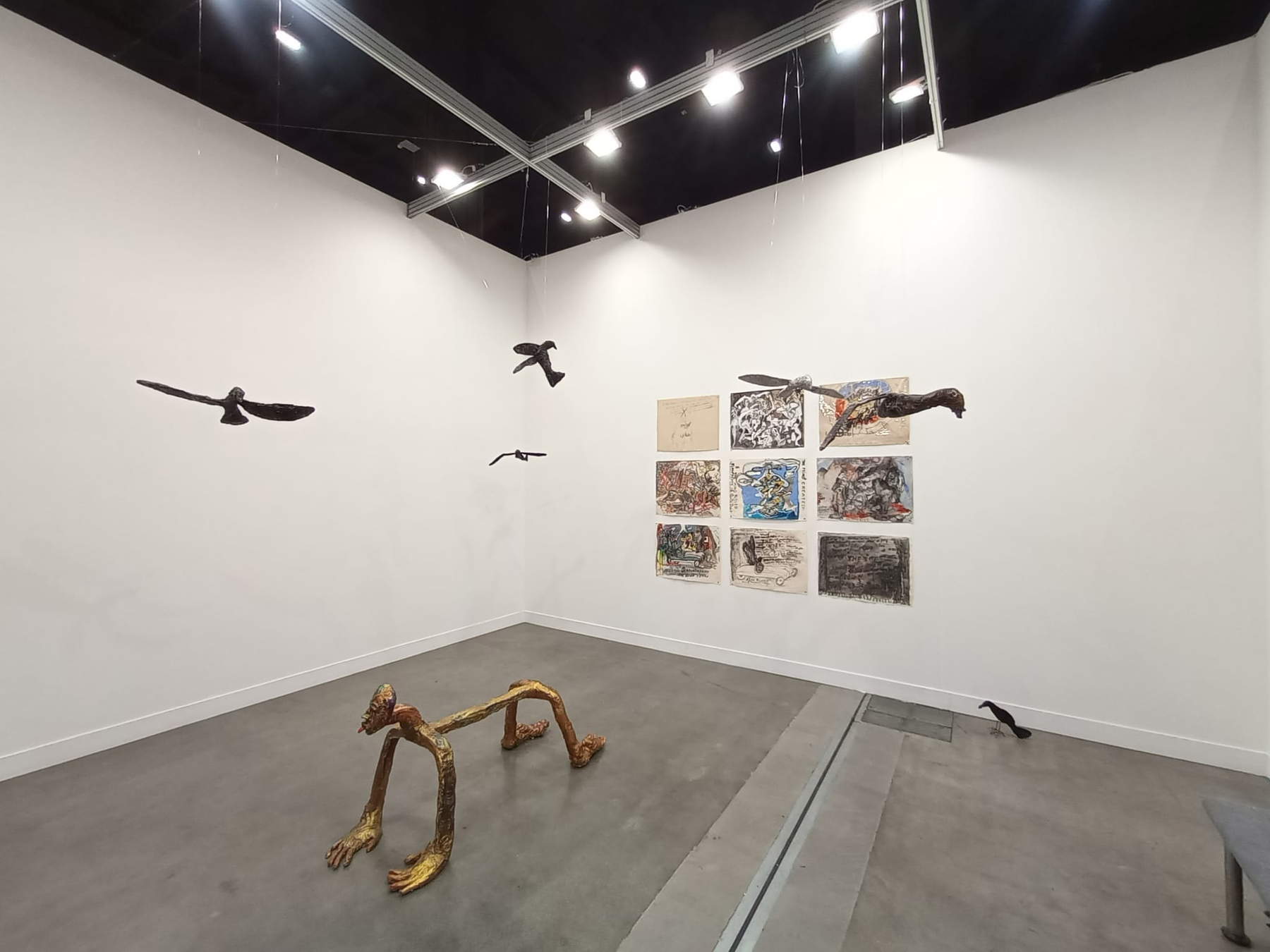
7. Kaufmann Repetto
Of the stands devoted to more articulated exhibitions, Kaufmann Repetto ’s is certainly one of the most scenic, if only because of the huge canvases by Argentinian Vivian Suter, with their intense colors reminiscent of those of the tropical forests in which the artist long lived, or Lily Van der Stokker’s large flowers, works that are feminine and carefree but at the same time also quite ambiguous. The selection is completed with oepres by artists such as Adrian Paci, Elene Chantladze, Anthea Hamilton, Latifa Echakhch and several others.
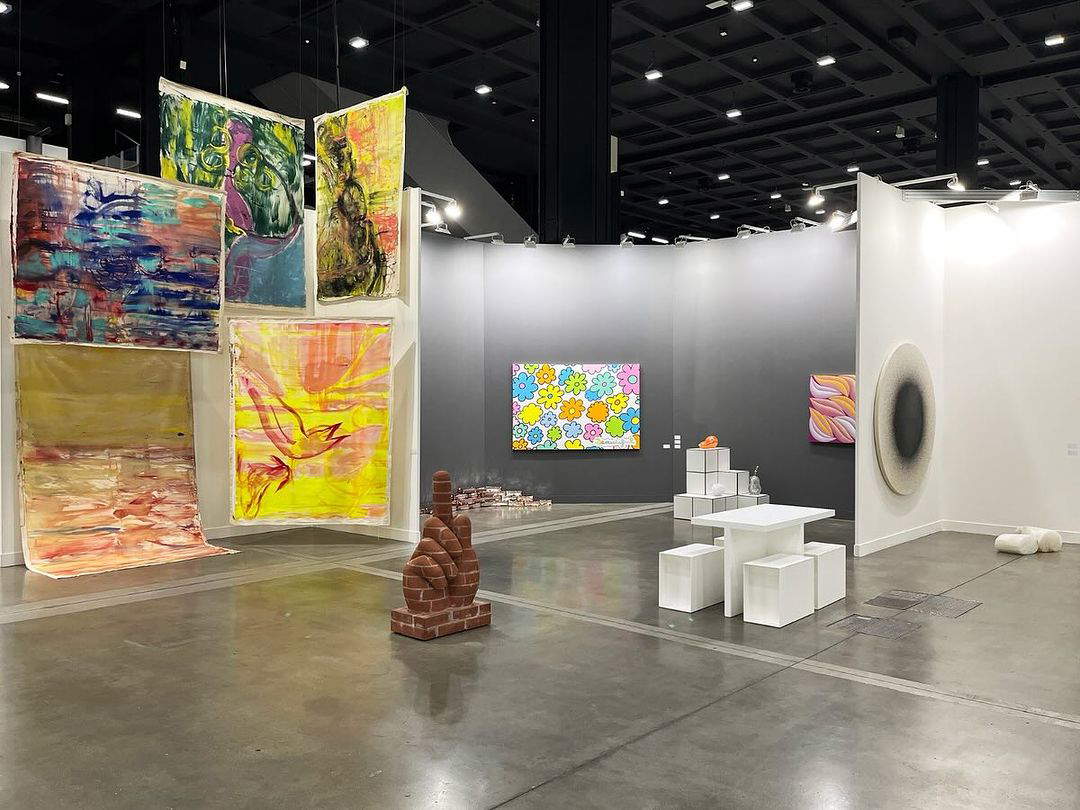
8. Marcorossi
The Pietrasanta gallery Marcorossi presents a single show dedicated to Giosetta Fioroni: not to be missed above all are the ceramic theaters, typical of the production of an artist whose works are distinguished by their fairy-tale, magical and fantastic atmospheres, capable of conveying a sense of wonder and enchantment to the viewer. Giosetta Fioroni, a multifaceted artist, is distinguished by her continuous expressive research that embraces a wide range of artistic media. Since her early work with silverware in the 1960s, she has gradually explored new artistic avenues, moving from painting on canvases and drawings made with industrial enamels and paints to using aluminum as a support for her works. Ceramics are part of his most recent research: a path undertaken since 1993, with production begun at the renowned Bottega Gatti in Faenza.
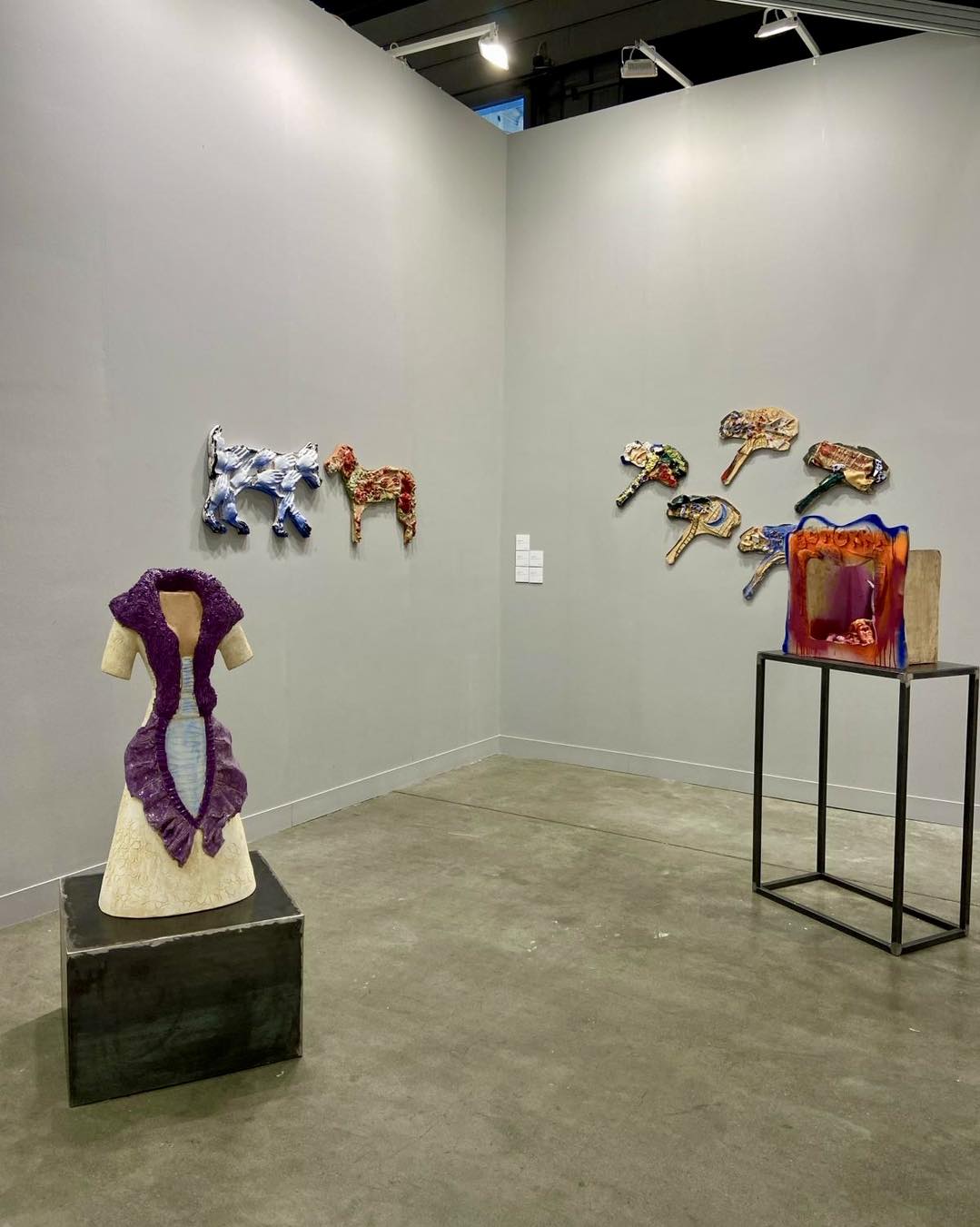
9. Paris-B
Three well-blended artists make up Paris-B’s booth. Laura Garcia Karras, born in France in 1988, with her manicured plants and a few old botanical plates to keep her company, offers paintings that reveal the guts of the idea with painting that is both soft and gestural. Jacques Julien, a Frenchman born in 1967 from Lons le Saunier, humorously combines the analytical and the poetic with his works. For him, sculpture is a starting point toward the invisible double, the missing body or the empty figure. Since the 1990s, he has developed a reflection on form: its elaboration, realization and abandonment. As a result, her work revolves around the practice of studio sculpture, where time passes and is lost in the manner of the life that takes place there, where the work is a series of empirical experiments that try to find a form of autonomy in tune with the territory that gave birth to it, with the relationship to space that remains at the center of her questioning. Finally, here is Léa Belooussovitch, born in Paris in 1989: typically starting from a violent image found in the media and derived from current events, the artist makes a double of it, an alternative, subjecting the initial image to a series of transformations that definitively deconstruct it. From the original clear and mechanical image, therefore, the resulting work becomes downy, velvety, almost dusty, forming clouds of color that merge into each other, to the point that, without knowing its origin, one might think that one is dealing with a purely abstract image.
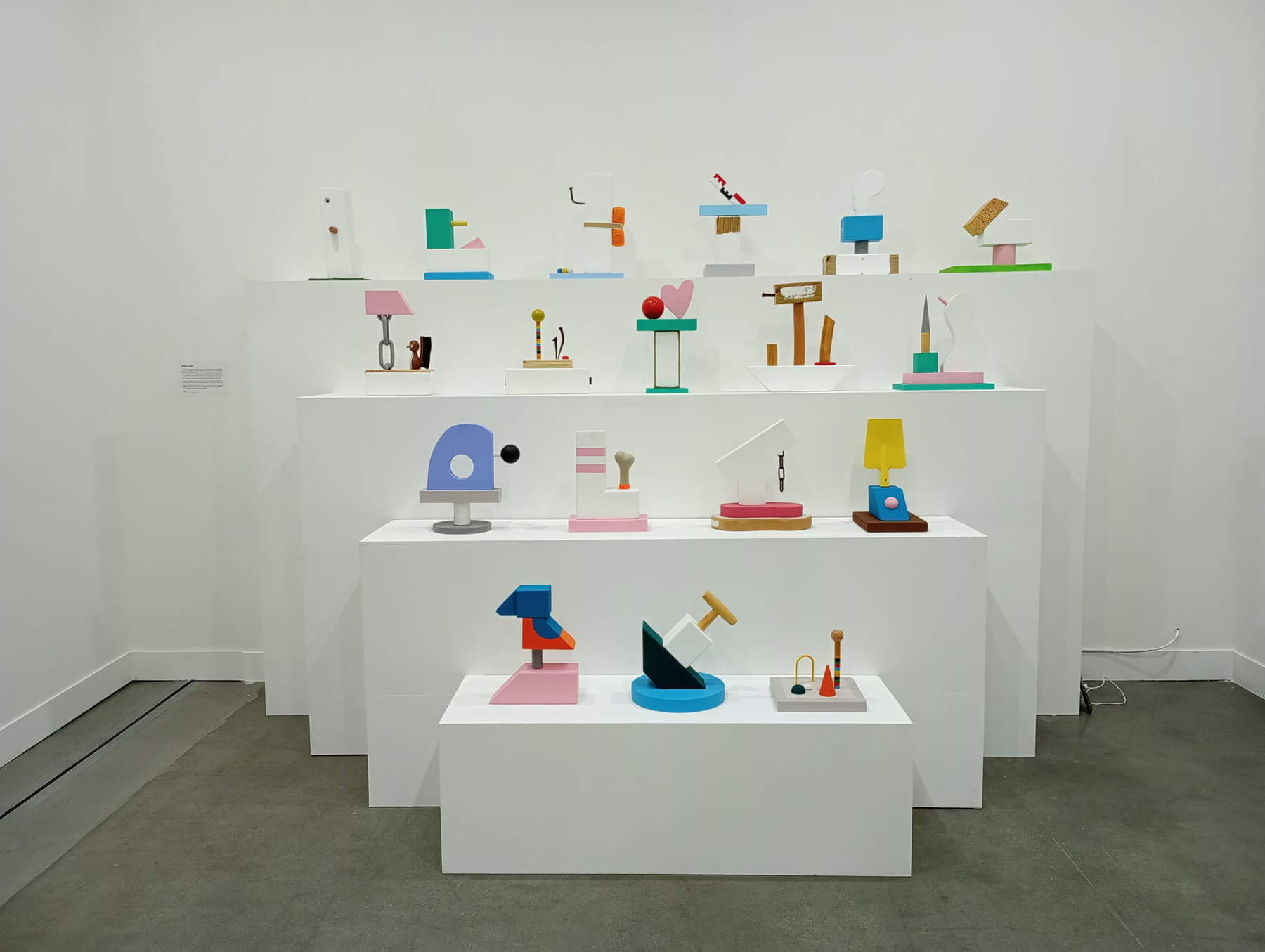
10. Sans Titre
Sans Titre presents a solo exhibition by German artist Robert Brambora, class of 1984. The exhibition combines two complementary series of works developed by the artist over the past year. Contemporary urban landscapes overlap with ceramic sculptures with a serene and contemplative air. The series of works, complemented by wallpaper in the background, invites a dialogue about the contrasts present in the world beyond the fair. Inspired by Italo Calvino’s novel The Invisible Cities, Brambora’s series of paintings on wood depict cityscapes and were produced using a Neo-Impressionist style characterized by a combination of traditional and contemporary techniques. Scenes of smog-shrouded cities evoke the effects of climate change; fires, heavy rains and apocalyptic scenes lend a sci-fi atmosphere. Brambora’s paintings evoke a highly surreal environment while evoking a sense of loneliness, desolation and boredom: aspects familiar to those who inhabit the vast, impersonal urban landscapes of contemporary capitalist cities. Above some of these painted landscapes appear fragments of digital texts and futuristic advertisements generated by artificial intelligence. The texts are superimposed on the paintings by UV printing techniques and create a distinctive visual effect, combining the industrial with the handmade, the intellect with the affection. The wallpaper, also designed by Brambora, depicts intertwining tongues, symbolizing the devilishness and tumult of urban environments. In sharp contrast to the dystopian and frenetic images in the paintings, we find other works by Brambora: large golden ceramic ears. These sculptures evoke a deep sense of serenity, stillness and meditation. In the hectic context of an art fair, they are meant to invite viewers to reflect on the nature of sensation and receptivity.
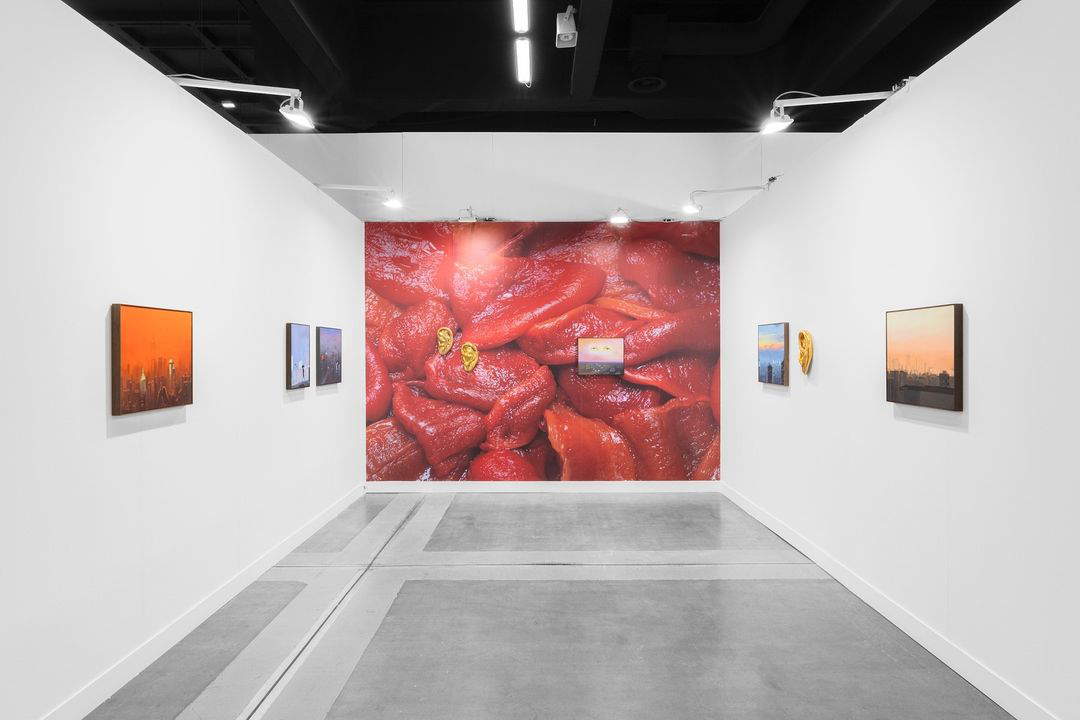
Warning: the translation into English of the original Italian article was created using automatic tools. We undertake to review all articles, but we do not guarantee the total absence of inaccuracies in the translation due to the program. You can find the original by clicking on the ITA button. If you find any mistake,please contact us.



























